
Villas and palaces in Milan are used to indicate public and private buildings in Milan of particular artistic and architectural value. Milan has always been an important centre with regard to the construction of historical villas and palaces, ranging from the Romanesque to the neo-Gothic, from Baroque to Rococo.

The Royal Palace of Milan was the seat of government in the Italian city of Milan for many centuries. Today, it serves as a cultural centre and it is home to international art exhibitions. It spans through an area of 7,000 square meters and it regularly hosts modern and contemporary art works and famous collections in cooperation with notable museums and cultural institutions from across the world. More than 1,500 masterpieces are on display annually.

Palazzo Castiglioni is an Art Nouveau palace of Milan, northern Italy. It was designed by Giuseppe Sommaruga in the Liberty style and built between 1901 and 1903. The rusticated blocks of the basement imitate a natural rocky shape, while the rest of the decorations are inspired by 18th century stuccos. The building is now used as the seat of the Unione Commercianti di Milano.

The Palazzo della Ragione is a historic building of Milan, Italy, located in Piazza Mercanti, facing the Loggia degli Osii. It was built in the 13th century and originally served as a broletto as well as a judicial seat. As it was the second broletto to be built in Milan, it is also known as the Broletto Nuovo.
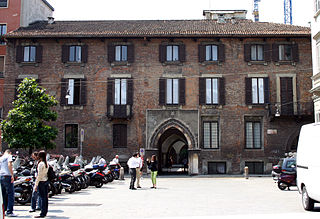
Palazzo Borromeo is a 14th-century building located at piazza Borromeo 12 in Milan, region of Lombardy, Italy. It was built as the home and business headquarters of the Borromeo family, merchant-bankers from Tuscany. Some of the building complex was badly damaged during World War II in Allied bombings of 1943 but was reconstructed and restored to its 15th-century appearance. It contains an important fresco cycle from the 1440s and is one of the finest examples of a Milanese patrician palace from the early Renaissance.
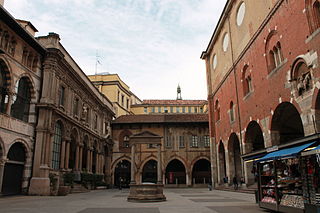
Piazza Mercanti is a central city square of Milan, Italy. It is located between Piazza del Duomo, which marks the centre of the modern city of Milan, and Piazza Cordusio, and it used to be the heart of the city in the Middle Ages. At the time, the square was larger than it is now and known as "Piazza del Broletto", after the "Broletto Nuovo", the palace that occupied the centre of the square. In the 13th century, there were six entry points to the square, each associated to a specific trade, from sword blacksmiths to hat makers.

Casa Panigarola, also known as Palazzo dei Notai, is a historic building of Milan, Italy, located in Piazza Mercanti, former city centre in the Middle Ages. It is named after the House of Panigarola, a family of notaries from Gallarate, that owned the building until 1741. The building thus served as a notary seat, and the activities therein were strictly related to those that occurred in the adjacent Palazzo della Ragione, where trials were held.

The Palazzo delle Scuole Palatine is a historic building of Milan, Italy, located in Piazza Mercanti, the former city centre in the Middle Ages. It served as the seat of the most prestigious higher school of medieval Milan. Many notable Milanese scholars of different ages studied or taught in these schools; Augustine of Hippo and Cesare Beccaria, among others, served as teachers in the Palatine. The current building dates back to 1644, when it replaced an older one, which had the same function and was destroyed by a fire.

The Piazza San Sepolcro is a piazza in the center of Milan not far from the Piazza del Duomo.

The Bergomi Palace is a 14th-century building in Mirandola, in the province of Modena, Italy.
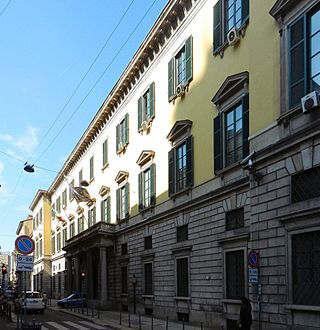
The Prefecture, Milan, also known as Palazzo Diotti, is a historic neoclassical building which has been the location of the office of the Prefect of Milan since 1859. The building is situated at 31, Corso Monforte in the city.

Art Nouveau in Milan indicates the spread of such artistic style in the city of Milan between the early years of the 20th century and the outbreak of the First World War. In the Lombard capital, art nouveau, called StileLiberty in Italian, found—thanks to its close relationship with the rampant industrial bourgeoisie of the time—a fertile ground for its rapid development, during which it oscillated between the influences of French Art Nouveau, German Jugendstil and eclecticism.
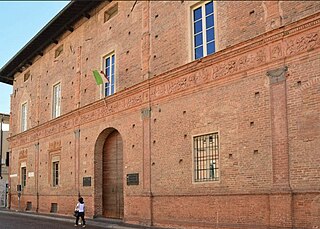
Palace Carminali Bottigella is a noble palace built by the ancient Beccaria family from Pavia. The original structure from the Sforza era was built between 1490 and 1499. The façade, which retains the original terracotta decorations, is one of the major examples of Renaissance civil building in Pavia.
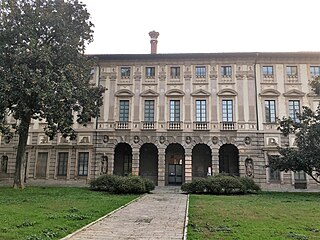
Palazzo del Maino is a Baroque palace in Pavia, in Lombardy.

The Casa dei Grifi is a historic building in Milan, located in Via Valpetrosa 5.

Palazzo Carmagnola is a palazzo quattrocentesco in Milano, which was remodelled several times in the following centuries. Historically belonging to the Sestiere di Porta Comasina, it is located in via Rovello 2.
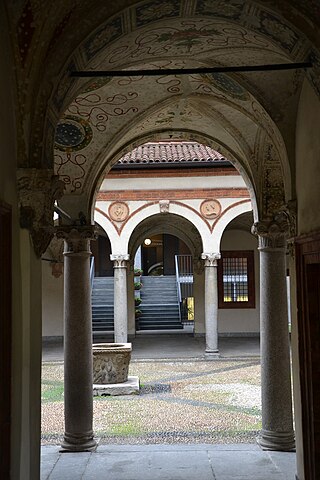
The Palazzo Dal Verme was the noble residence of one of the most powerful families of the Visconti and Sforza court in the 15th century. The courtyard remains today, one of the greatest examples of civil construction from the Renaissance era in Milan. It is located at 3 Via Giacomo Puccini.

Palazzo Isimbardi, also palazzo della Provincia, is a historic building in Milan located at 35 Corso Monforte, the seat of the Metropolitan City of Milan.
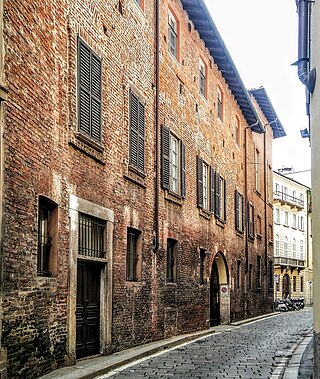
Casa Radice Fossati' is a historic building in Milan located at via Cappuccio no. 13

Palazzo Recalcati is a 16th century palace in Milan (Italy), enlarged between the 17th and 18th centuries. Historically belonging to the district of Porta Ticinese, it is located in Via Amedei 8.





















